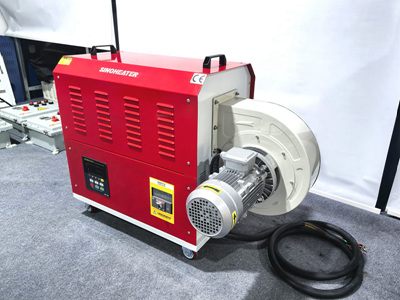Troubleshooting and Repairing Heat Blower Issues in High-Altitude Environments
High-altitude conditions, characterized by lower air density and oxygen levels, can impact heat blower performance and reliability. Identifying altitude-related problems early prevents overheating, component failure, and reduced efficiency. Below are detailed steps to diagnose and fix common issues in high-altitude settings.
1. Recognizing Symptoms of High-Altitude-Induced Failures
Understanding signs of altitude-related strain helps prioritize repairs.
- Reduced Heat Output or Airflow: Lower air density at high altitudes reduces the heat blower’s ability to transfer heat efficiently. The unit may struggle to reach set temperatures or produce weak airflow.
- Frequent Overheating or Shutdowns: Thinner air provides less cooling for the motor and heating elements, causing them to overheat. The unit may shut down intermittently or display thermal error codes.
- Abnormal Motor Noises or Vibrations: The motor may work harder to compensate for reduced airflow, leading to increased strain, noise, or premature wear.
2. Understanding the Impact of High Altitude on Heat Blower Components
High altitudes affect critical systems in the following ways:
- Motor Overload: With less oxygen, the motor may draw higher current to maintain performance, increasing heat generation. Over time, this can degrade windings or insulation.
- Heating Element Inefficiency: Lower air density reduces heat dissipation, causing the heating element to overheat or cycle on/off rapidly. This can shorten its lifespan.
- Control System Malfunctions: Altitude-related pressure changes may affect pressure sensors or airflow switches, leading to incorrect readings or erratic operation.
3. Inspecting and Cleaning the Heat Blower for Altitude-Related Debris
High-altitude environments often coincide with dusty or windy conditions, exacerbating component clogging.
- Check Air Intake and Exhaust Vents: Dust, sand, or debris may accumulate faster at altitude due to reduced air filtration efficiency. Use compressed air or a vacuum to clear blockages.
- Inspect the Fan and Blower Assembly: Thin air may cause the fan to spin faster, increasing wear. Look for loose blades, debris buildup, or imbalanced rotation.
- Clean or Replace Air Filters: If the unit has filters, they may clog more quickly at altitude. Clean reusable filters or replace disposable ones to maintain airflow.
4. Testing and Adjusting Motor Performance
Address motor strain caused by high-altitude conditions.
- Measure Current Draw: Use a multimeter to check if the motor is drawing excessive current. High current indicates overload, which may require derating the unit or improving ventilation.
- Lubricate Moving Parts: Reduced air density can increase friction in bearings or gears. Apply lightweight machine oil to lubricate the motor shaft, fan bearings, and other moving components.
- Check for Worn Windings or Insulation: Overheating due to altitude may damage motor windings. Inspect for burnt smells, discoloration, or exposed wires. Replace the motor if insulation is compromised.
5. Evaluating and Repairing the Heating Element
Ensure the heating element functions safely and efficiently at altitude.
- Test for Continuity and Resistance: Use a multimeter to verify the heating element’s resistance matches specifications. Incorrect readings may indicate damage from overheating.
- Inspect for Overheating Signs: Look for melted insulation, warped coils, or discoloration on the element. Replace it if signs of thermal stress are present.
- Adjust Temperature Settings: If the unit allows, lower the maximum temperature setting to reduce strain on the heating element in low-density air.
6. Addressing Control System and Sensor Issues
Fix altitude-related errors in sensors or control logic.
- Calibrate Pressure or Airflow Sensors: High-altitude pressure changes may skew sensor readings. Recalibrate sensors using the manufacturer’s guidelines or replace them if calibration fails.
- Check for Loose or Corroded Wiring: Vibration at altitude can loosen connections. Inspect wiring harnesses for fraying, loose terminals, or corrosion. Tighten connections and apply dielectric grease to prevent oxidation.
- Update Firmware (If Applicable): Some heat blowers allow firmware updates to improve altitude compensation. Check the manufacturer’s website for available patches.
7. Improving Ventilation and Cooling
Enhance airflow to counteract altitude-related overheating.
- Install Additional Fans or Vents: If feasible, add auxiliary fans or enlarge exhaust vents to improve heat dissipation. Ensure modifications do not void warranties.
- Use a High-Altitude Derating Kit (If Available): Some manufacturers offer derating kits that adjust the unit’s power output or fan speed for altitude. Install these kits following instructions.
- Position the Unit in a Well-Ventilated Area: Avoid enclosing the heat blower in tight spaces. Ensure at least 12 inches (30 cm) of clearance around vents for optimal airflow.
8. Preventing Future High-Altitude Failures
Adopt measures to protect the heat blower in mountainous or elevated regions.
- Schedule More Frequent Maintenance: Clean filters, vents, and fans monthly or more often in dusty high-altitude areas. Check motor current and heating element resistance quarterly.
- Monitor Operating Temperatures: Use infrared thermometers to track motor and heating element temperatures. Shut down the unit if temperatures exceed safe limits.
- Educate Users on Altitude Limitations: Inform operators that the heat blower may perform differently at altitude and advise against pushing it beyond recommended settings.
By following these steps, users can repair and maintain heat blowers in high-altitude environments. Prioritize safety during testing and modifications, and avoid operating the unit outside its specified altitude range until adjustments are made. Regular maintenance and proactive upgrades ensure long-term reliability.




